
Me-LLaMA
A novel medical large language model family with 13/70B parameters, which have SOTA performances on various medical tasks
Stars: 126

Me LLaMA introduces a suite of open-source medical Large Language Models (LLMs), including Me LLaMA 13B/70B and their chat-enhanced versions. Developed through innovative continual pre-training and instruction tuning, these models leverage a vast medical corpus comprising PubMed papers, medical guidelines, and general domain data. Me LLaMA sets new benchmarks on medical reasoning tasks, making it a significant asset for medical NLP applications and research. The models are intended for computational linguistics and medical research, not for clinical decision-making without validation and regulatory approval.
README:
Me LLaMA introduces a groundbreaking suite of open-source medical Large Language Models (LLMs), including the foundation models Me LLaMA 13B/70B and their chat-enhanced versions, Me LLaMA 13B-chat/70B-chat. Developed through the innovative continual pre-training and instruction tuning of LLaMA2, these models leverage a vast medical corpus. This corpus encompasses selected PubMed papers and abstracts, a novel dataset of internationally-recognized medical guidelines, and a general domain corpus, positioning Me LLaMA at the forefront of medical AI research.
With its domain-specific advancements, Me LLaMA sets new benchmarks on a wide array of medical reasoning tasks. This makes Me LLaMA a significant asset for medical NLP applications and research.
The code, datasets, and models are available for non-commercial use.
- Code: See above.
- Datasets: Check our Hugging Face collection.
- Models: Please visit our PhysioNet repository. Note that a PhysioNet account, training, and data usage agreement are required.
This software and model are provided "as is", without warranty of any kind, express or implied, including but not limited to the warranties of merchantability, fitness for a particular purpose, and noninfringement. In no event shall the authors, contributors, or copyright holders be liable for any claim, damages, or other liability, whether in an action of contract, tort, or otherwise, arising from, out of, or in connection with the software or the use or other dealings in the software.
The Me LLaMA models are research tools intended for use in the field of computational linguistics and medicine. They are not intended to be used as diagnostic tools or for clinical decision-making without appropriate validation and regulatory approval. Users of the Me LLaMA models should be aware of their responsibilities to ensure the ethical and appropriate use of this technology, including adherence to any applicable legal and regulatory requirements.
The content and data provided with the models do not replace the expertise of healthcare professionals. Healthcare professionals should use their professional judgment in evaluating the outputs of the Me LLaMA models. Patients should not use the model outputs for self-diagnosis or treatment without consulting a qualified healthcare provider. The information is not intended for clinical decision making, is not intended to be used in the diagnosis or treatment of patients and may not be useful or appropriate for any clinical purpose.
Additionally, users are expressly prohibited from sharing or redistributing any outputs generated from the Me LLaMA models without explicit permission from the authors. This includes, but is not limited to, publishing, distributing, or making the generated outputs available to third parties in any form, whether for commercial purposes or not. This restriction is put in place to ensure responsible use of the technology and to respect the intellectual property rights associated with the models and their outputs. Violation of these terms may result in legal action and revocation of access to the models.
- Model License: PhysioNet Credentialed Health Data License 1.5.0
- Code License: MIT LICENSE
- Continued-pretrained from model: Llama-2 models, extensively adapted for the medical domain through targeted pre-training and instruction tuning
- Evaluation Datasets: Huggingface Evaluation Datasets Collection
- Paper: Me LLaMA: Foundation Large Language Models for Medical Applications
The development of Me LLaMA involved a meticulous process of continual pre-training and instruction tuning of the LLaMA2 models, incorporating an extensive 129B tokens and 214K instruction tuning samples from a diverse array of general, biomedical, and clinical domains. This comprehensive approach aimed to balance domain-specific knowledge with a broader understanding of general context, thereby effectively mitigating catastrophic forgetting issues.
The mixed continual pre-training dataset, comprising 129B tokens, includes a wide range of biomedical literature, clinical notes, and general domain data. This dataset is designed to ensure a deep focus on medical domain knowledge while incorporating a broad spectrum of general knowledge. The dataset's composition includes:
- Biomedical Papers: Integration of a vast collection from PubMed Central and PubMed Abstracts.
- Clinical Notes: Inclusion of de-identified free-text clinical notes from MIMIC-IV and MIMIC-CXR.
- General Domain Data: A subset from the RedPajama dataset, replicating LLaMA's pre-training data.
The pre-training utilized a ratio of 15:1:4 for biomedical, clinical to general domain data, aiming to maintain a strong medical focus while also broadening the model's understanding.
The Me LLaMA models, 13B and 70B, were developed through continuous pre-training and instruction tuning on the University of Florida's HiPerGator supercomputer, equipped with 160 A100 80GB GPUs. The process aimed to adapt the LLaMA2 models for enhanced comprehension and generation of medically relevant text. The training regimen involved:
- Optimization: Use of the AdamW optimizer with specific hyperparameters (β1=0.9, β2=0.95), a learning rate of 8e-6, and a weight decay of 0.00001.
- Learning Rate Scheduler: A cosine learning rate scheduler with a 0.05 warmup ratio for gradual adaptation.
- Precision and Efficiency: bf16 precision for computational efficiency and gradient accumulation over 16 steps, limited to one epoch.
- Model Parallelism: Utilization of DeepSpeed for effective model parallelism.
Following the pre-training phase, Me LLaMA models underwent instruction tuning using 8 H100 GPUs for 3 epochs, employing a learning rate of 1e-5. This phase focused on refining the models' ability to follow instructions and generalize across medical tasks, utilizing LoRA-based parameter-efficient fine-tuning for enhanced performance.
This detailed training procedure underscores the comprehensive approach taken in developing Me LLaMA models, leveraging advanced computational resources and methodologies to achieve state-of-the-art performance in the medical domain.
To utilize the Me LLaMA model locally, begin by acquiring the necessary model files from our PhysioNet project.
First, ensure that both the torch and transformers libraries are installed in your Python environment. These libraries are required for working with the model.
For basic text generation, you'll employ a pipeline from the transformers library. This method simplifies the process of generating text. Here's how you can set it up:
from transformers import pipeline
# Ensure you replace "FOLDER_PATH_TO_MODEL" with the actual path to your model files.
pipe = pipeline("text-generation", model="FOLDER_PATH_TO_MODEL")
# Example usage for generating text.
generated_text = pipe("The medical condition is characterized by", num_return_sequences=1)
print(generated_text)This code snippet demonstrates how to generate text based on a prompt. The num_return_sequences=1 argument specifies that you want to generate one sequence of text.
For tasks requiring more customization or fine-tuning capabilities, you might prefer directly loading the tokenizer and model. This approach gives you more control over the text generation process, allowing you to adjust parameters like the maximum length of the generated text. Here's a more detailed example:
from transformers import AutoTokenizer, AutoModelForCausalLM
# Load the tokenizer and model from your local model directory.
# Don't forget to replace "FOLDER_PATH_TO_MODEL" with the actual path to your model files.
tokenizer = AutoTokenizer.from_pretrained("FOLDER_PATH_TO_MODEL")
model = AutoModelForCausalLM.from_pretrained("FOLDER_PATH_TO_MODEL")
# Tokenizing input text for the model.
input_ids = tokenizer("[INPUT SENTENCE]", return_tensors="pt").input_ids
# Generating output based on the input_ids.
# You can adjust the max_length parameter as necessary for your use case.
generated_tokens = model.generate(input_ids, max_length=50)
# Decoding the generated tokens to produce readable text.
generated_text = tokenizer.decode(generated_tokens[0], skip_special_tokens=True)
print(generated_text)This setup allows for more nuanced interactions with the model, such as fine-tuning on specific datasets or modifying the generation parameters for different outputs. Remember to replace "[INPUT SENTENCE]" with the sentence or prompt you want the model to expand on or respond to.
git clone [email protected]:BIDS-Xu-Lab/Me-LLaMA.git --recursive
cd Me-LLaMA
pip install poetry
poetry install
cd src/medical-evaluation
poetry run pip install -e .[multilingual]
poetry run python -m spacy download en_core_web_lgBefore evaluation, please download BART checkpoint to src/metrics/BARTScore/bart_score.pth.
For automated evaluation, please follow these instructions:
-
Huggingface Transformer
To evaluate a model hosted on the HuggingFace Hub (for instance, llama2-7b-hf), change this command in
scripts/run_evaluation.sh:
poetry run python src/eval.py \
--model "hf-causal-vllm" \
--model_args "use_accelerate=True,pretrained=meta-llama/Llama-2-7b-chat-hf,use_fast=False" \
--tasks "PUBMEDQA,MedQA,MedMCQA,EmrQA,i2b2,DDI2013,hoc,MTSample,PUBMEDSUM,MimicSum,BioNLI,MedNLI"Then run bash command:
bash scripts/run_evaluation.shMore details can be found in the lm_eval documentation.
- Commercial APIs
Perform the same steps as the open-sourced models, first to change the bash file with:
export OPENAI_API_SECRET_KEY=YOUR_KEY_HERE
poetry run python src/eval.py \
--model gpt-4 \
--tasks "PUBMEDQA,MedQA,MedMCQA,EmrQA,i2b2,DDI2013,hoc,MTSample,PUBMEDSUM,MimicSum,BioNLI,MedNLI"Please note, for tasks such as NER, the automated evaluation is based on a specific pattern. This might fail to extract relevant information in zero-shot settings, resulting in relatively lower performance compared to previous human-annotated results.
@misc{xie2024llama,
title={Me LLaMA: Foundation Large Language Models for Medical Applications},
author={Qianqian Xie and Qingyu Chen and Aokun Chen and Cheng Peng and Yan Hu and Fongci Lin and Xueqing Peng and Jimin Huang and Jeffrey Zhang and Vipina Keloth and Huan He and Lucila Ohno-Machido and Yonghui Wu and Hua Xu and Jiang Bian},
year={2024},
eprint={2402.12749},
archivePrefix={arXiv},
primaryClass={cs.CL}
}
For Tasks:
Click tags to check more tools for each tasksFor Jobs:
Alternative AI tools for Me-LLaMA
Similar Open Source Tools

Me-LLaMA
Me LLaMA introduces a suite of open-source medical Large Language Models (LLMs), including Me LLaMA 13B/70B and their chat-enhanced versions. Developed through innovative continual pre-training and instruction tuning, these models leverage a vast medical corpus comprising PubMed papers, medical guidelines, and general domain data. Me LLaMA sets new benchmarks on medical reasoning tasks, making it a significant asset for medical NLP applications and research. The models are intended for computational linguistics and medical research, not for clinical decision-making without validation and regulatory approval.
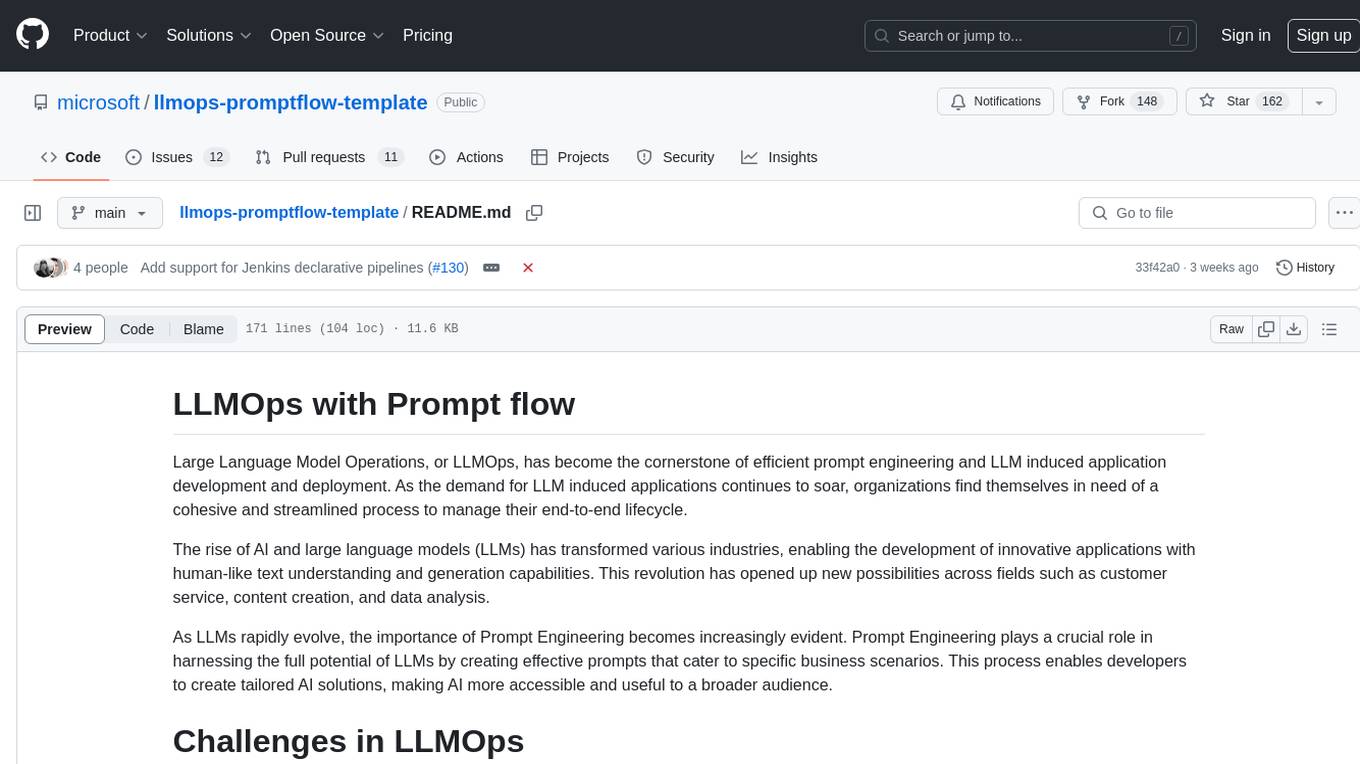
llmops-promptflow-template
LLMOps with Prompt flow is a template and guidance for building LLM-infused apps using Prompt flow. It provides centralized code hosting, lifecycle management, variant and hyperparameter experimentation, A/B deployment, many-to-many dataset/flow relationships, multiple deployment targets, comprehensive reporting, BYOF capabilities, configuration-based development, local prompt experimentation and evaluation, endpoint testing, and optional Human-in-loop validation. The tool is customizable to suit various application needs.
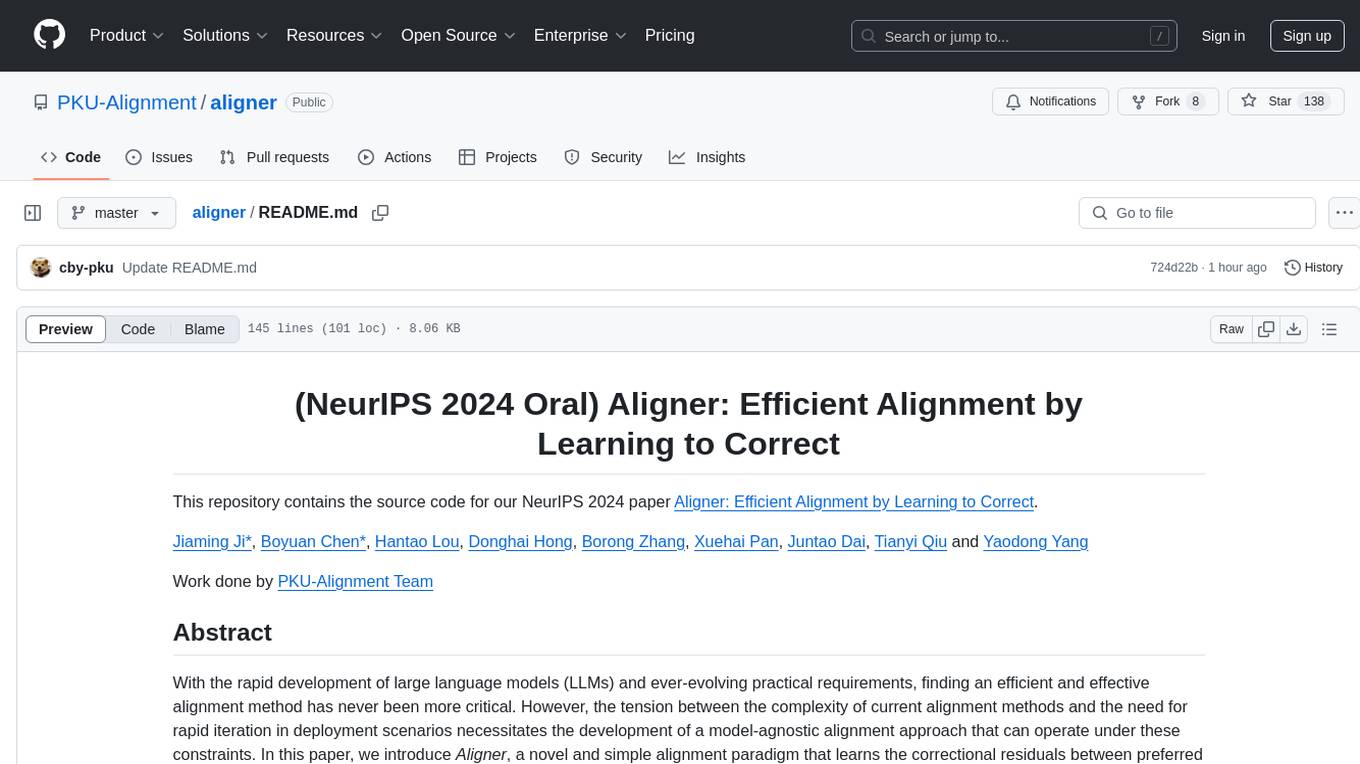
aligner
Aligner is a model-agnostic alignment tool designed to efficiently correct responses from large language models. It redistributes initial answers to align with human intentions, improving performance across various LLMs. The tool can be applied with minimal training, enhancing upstream models and reducing hallucination. Aligner's 'copy and correct' method preserves the base structure while enhancing responses. It achieves significant performance improvements in helpfulness, harmlessness, and honesty dimensions, with notable success in boosting Win Rates on evaluation leaderboards.
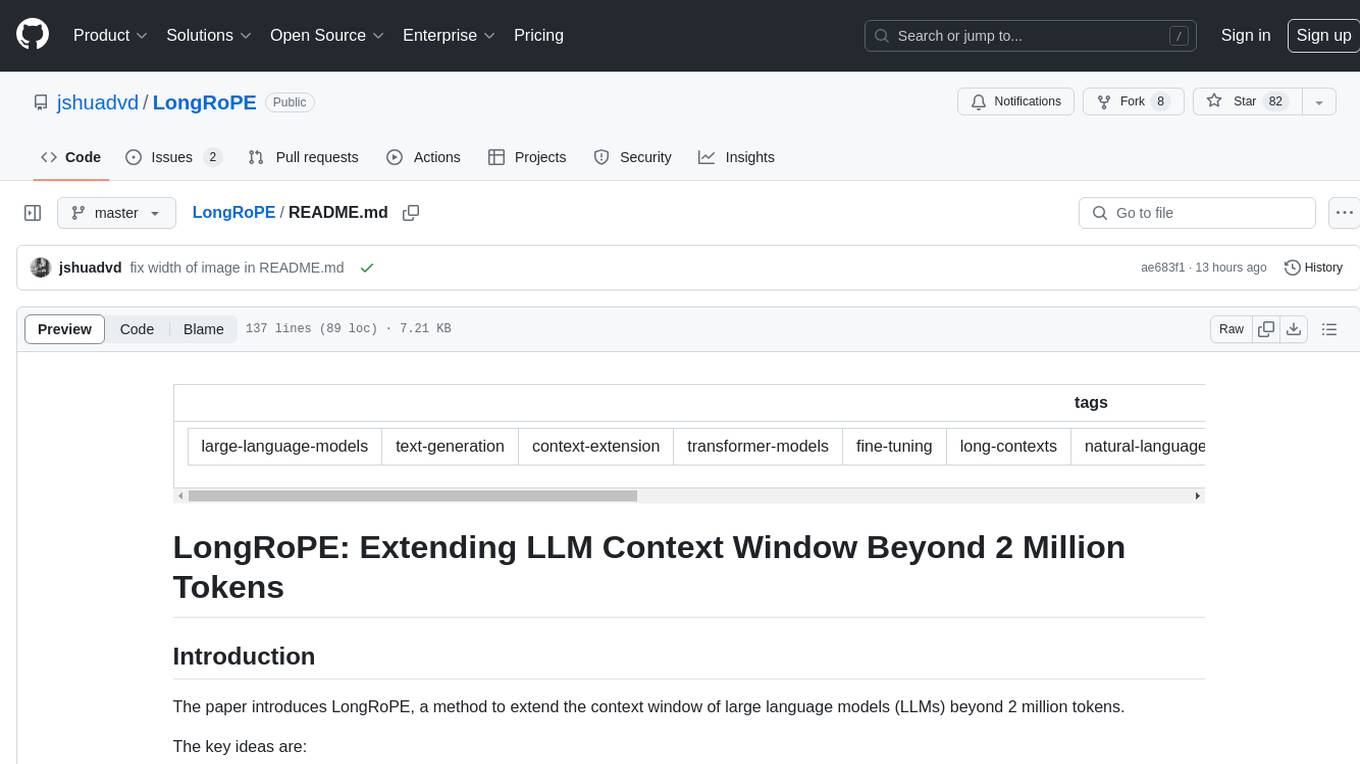
LongRoPE
LongRoPE is a method to extend the context window of large language models (LLMs) beyond 2 million tokens. It identifies and exploits non-uniformities in positional embeddings to enable 8x context extension without fine-tuning. The method utilizes a progressive extension strategy with 256k fine-tuning to reach a 2048k context. It adjusts embeddings for shorter contexts to maintain performance within the original window size. LongRoPE has been shown to be effective in maintaining performance across various tasks from 4k to 2048k context lengths.
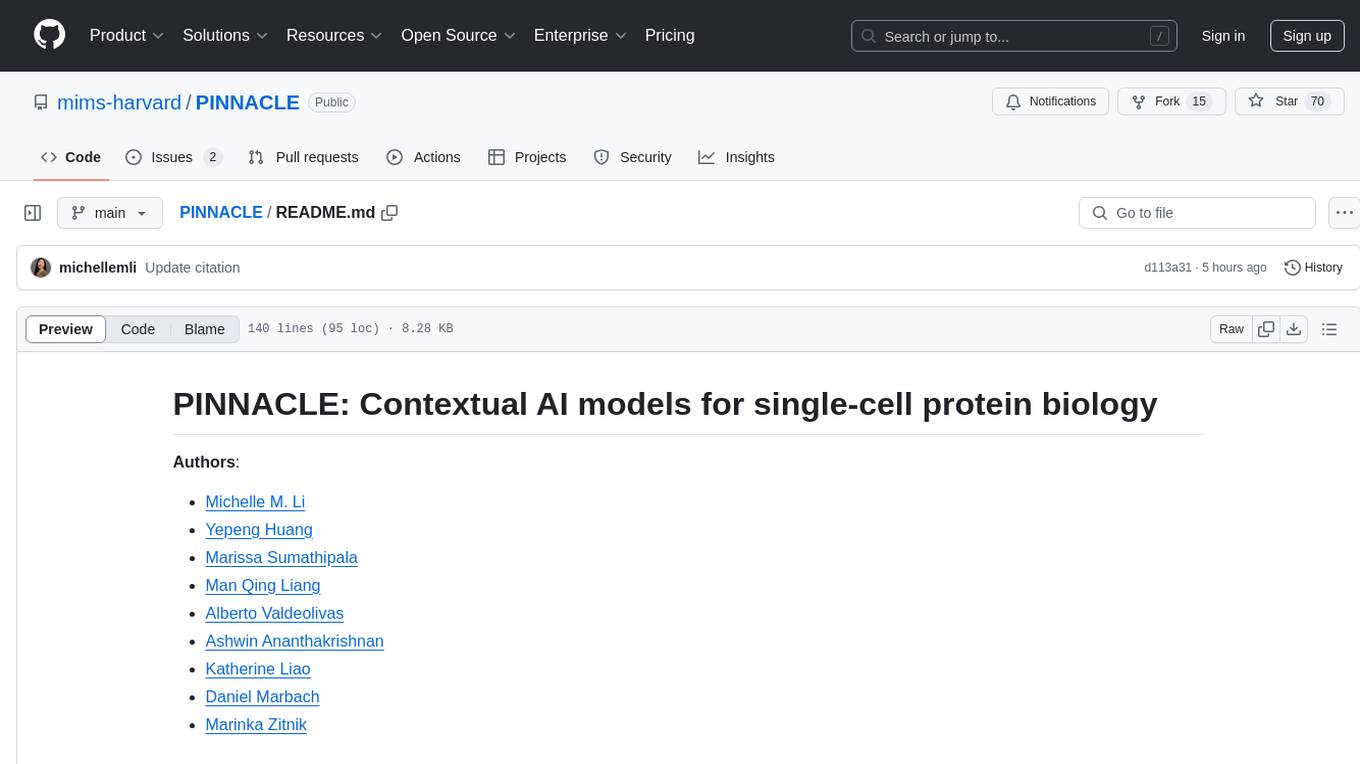
PINNACLE
PINNACLE is a flexible geometric deep learning approach that trains on contextualized protein interaction networks to generate context-aware protein representations. It provides protein representations split across various cell-type contexts from different tissues and organs. The tool can be fine-tuned to study the genomic effects of drugs and nominate promising protein targets and cell-type contexts for further investigation. PINNACLE exemplifies the paradigm of incorporating context-specific effects for studying biological systems, especially the impact of disease and therapeutics.

Chinese-Tiny-LLM
Chinese-Tiny-LLM is a repository containing procedures for cleaning Chinese web corpora and pre-training code. It introduces CT-LLM, a 2B parameter language model focused on the Chinese language. The model primarily uses Chinese data from a 1,200 billion token corpus, showing excellent performance in Chinese language tasks. The repository includes tools for filtering, deduplication, and pre-training, aiming to encourage further research and innovation in language model development.
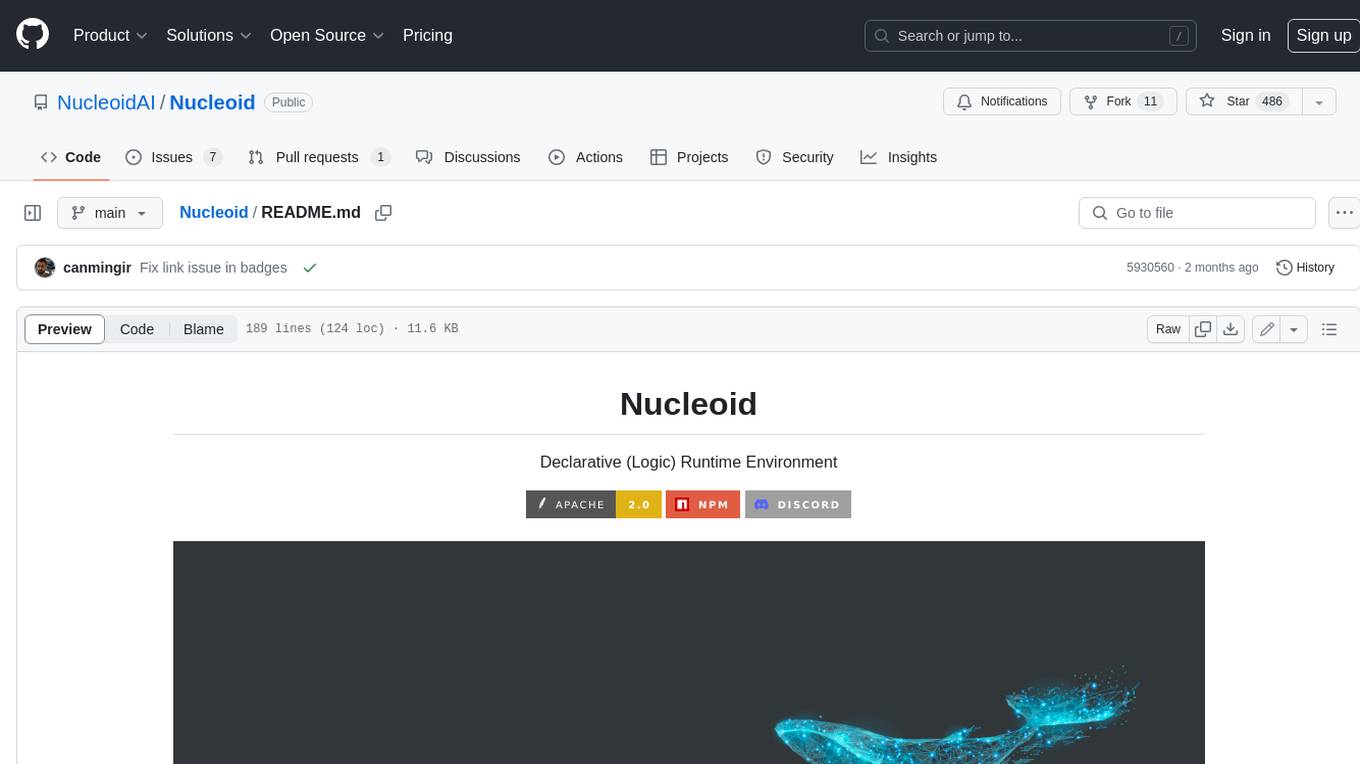
Nucleoid
Nucleoid is a declarative (logic) runtime environment that manages both data and logic under the same runtime. It uses a declarative programming paradigm, which allows developers to focus on the business logic of the application, while the runtime manages the technical details. This allows for faster development and reduces the amount of code that needs to be written. Additionally, the sharding feature can help to distribute the load across multiple instances, which can further improve the performance of the system.
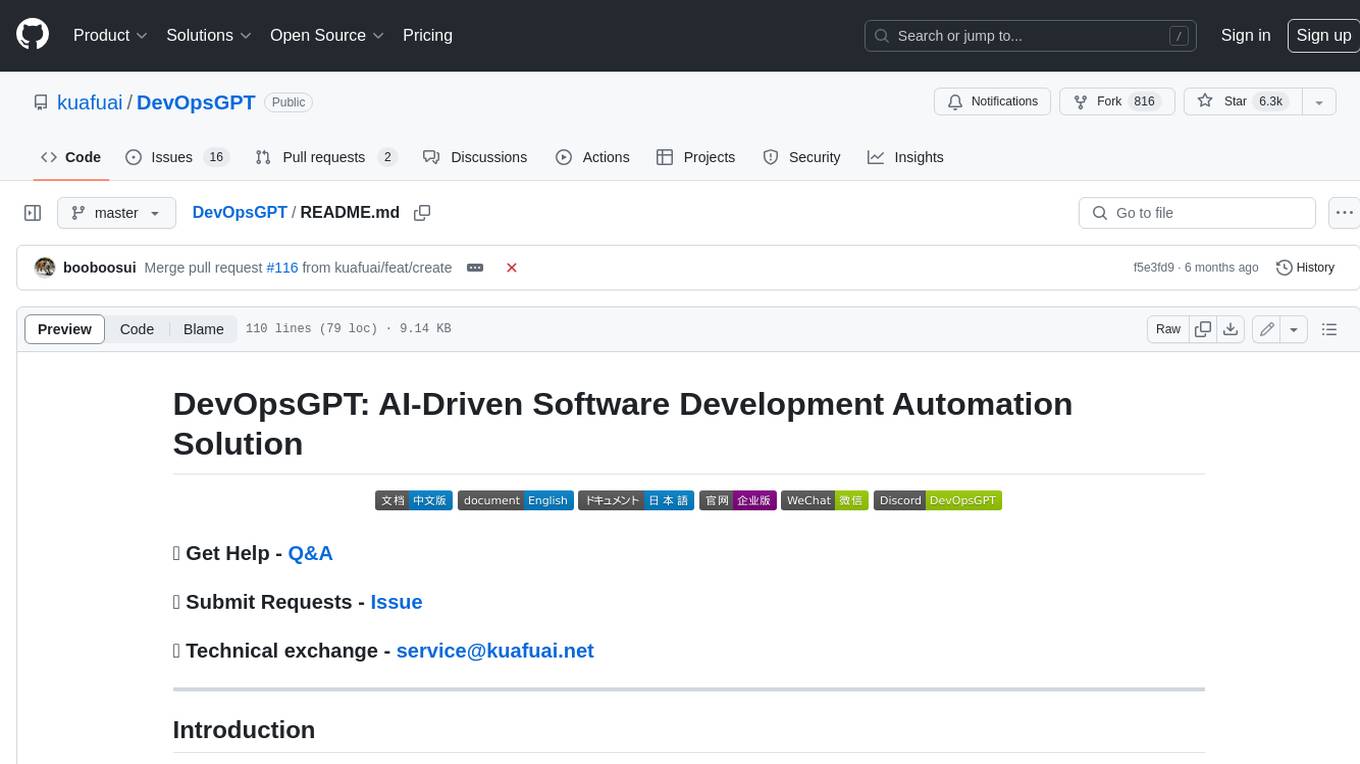
DevOpsGPT
DevOpsGPT is an AI-driven software development automation solution that combines Large Language Models (LLM) with DevOps tools to convert natural language requirements into working software. It improves development efficiency by eliminating the need for tedious requirement documentation, shortens development cycles, reduces communication costs, and ensures high-quality deliverables. The Enterprise Edition offers features like existing project analysis, professional model selection, and support for more DevOps platforms. The tool automates requirement development, generates interface documentation, provides pseudocode based on existing projects, facilitates code refinement, enables continuous integration, and supports software version release. Users can run DevOpsGPT with source code or Docker, and the tool comes with limitations in precise documentation generation and understanding existing project code. The product roadmap includes accurate requirement decomposition, rapid import of development requirements, and integration of more software engineering and professional tools for efficient software development tasks under AI planning and execution.
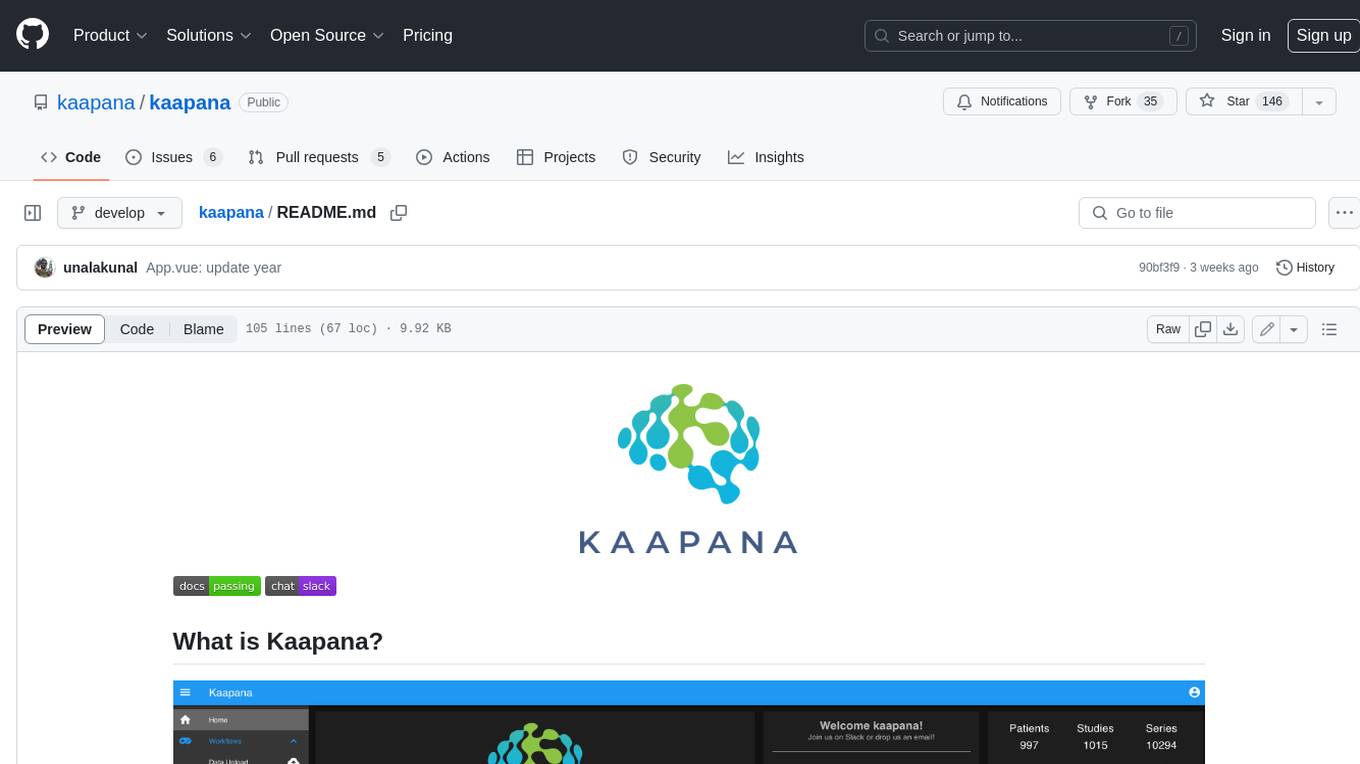
kaapana
Kaapana is an open-source toolkit for state-of-the-art platform provisioning in the field of medical data analysis. The applications comprise AI-based workflows and federated learning scenarios with a focus on radiological and radiotherapeutic imaging. Obtaining large amounts of medical data necessary for developing and training modern machine learning methods is an extremely challenging effort that often fails in a multi-center setting, e.g. due to technical, organizational and legal hurdles. A federated approach where the data remains under the authority of the individual institutions and is only processed on-site is, in contrast, a promising approach ideally suited to overcome these difficulties. Following this federated concept, the goal of Kaapana is to provide a framework and a set of tools for sharing data processing algorithms, for standardized workflow design and execution as well as for performing distributed method development. This will facilitate data analysis in a compliant way enabling researchers and clinicians to perform large-scale multi-center studies. By adhering to established standards and by adopting widely used open technologies for private cloud development and containerized data processing, Kaapana integrates seamlessly with the existing clinical IT infrastructure, such as the Picture Archiving and Communication System (PACS), and ensures modularity and easy extensibility.
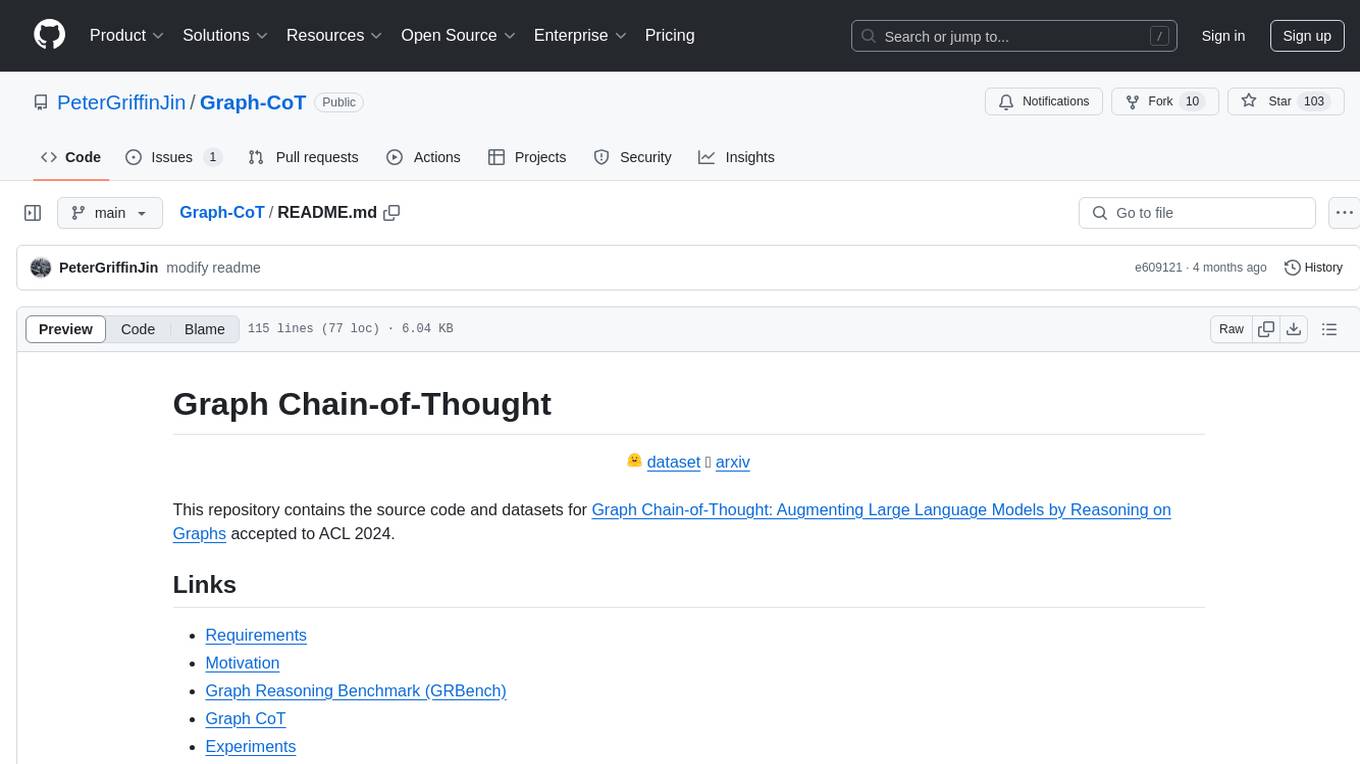
Graph-CoT
This repository contains the source code and datasets for Graph Chain-of-Thought: Augmenting Large Language Models by Reasoning on Graphs accepted to ACL 2024. It proposes a framework called Graph Chain-of-thought (Graph-CoT) to enable Language Models to traverse graphs step-by-step for reasoning, interaction, and execution. The motivation is to alleviate hallucination issues in Language Models by augmenting them with structured knowledge sources represented as graphs.
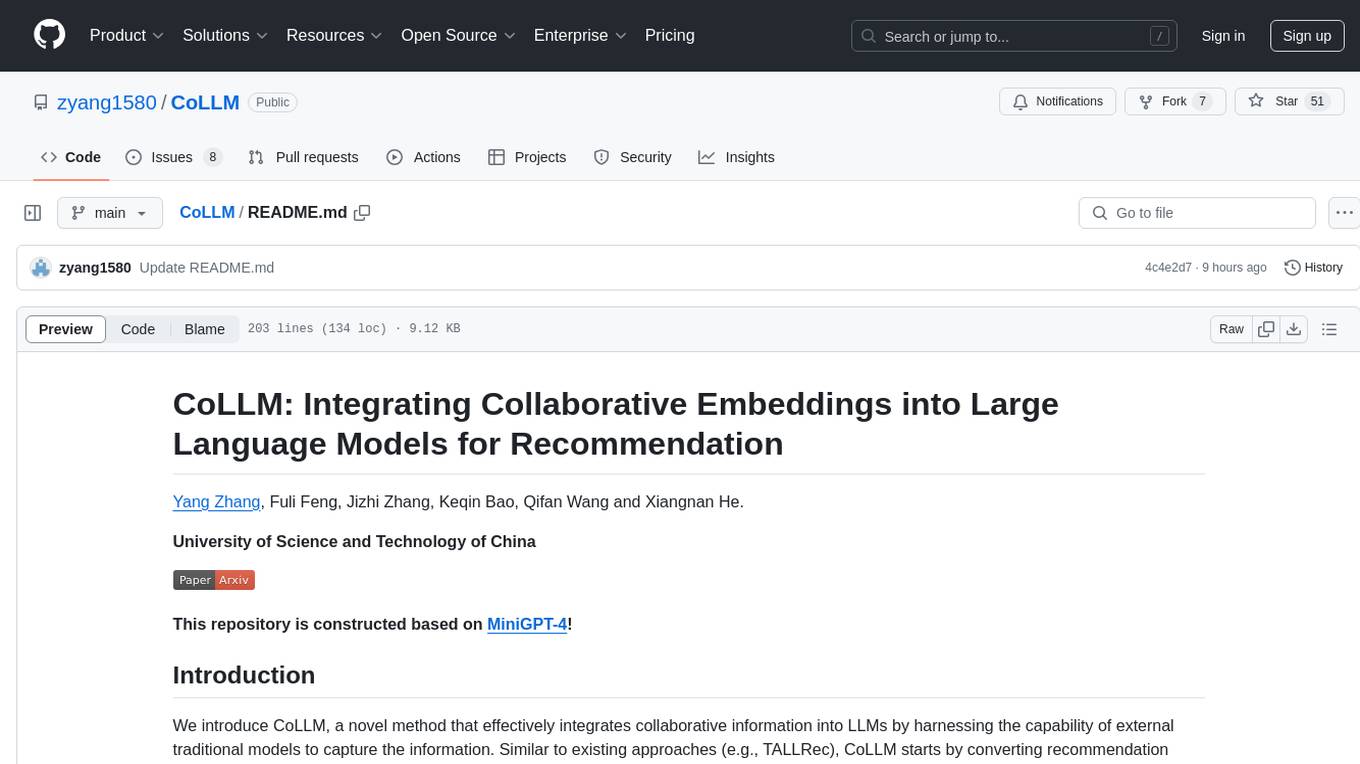
CoLLM
CoLLM is a novel method that integrates collaborative information into Large Language Models (LLMs) for recommendation. It converts recommendation data into language prompts, encodes them with both textual and collaborative information, and uses a two-step tuning method to train the model. The method incorporates user/item ID fields in prompts and employs a conventional collaborative model to generate user/item representations. CoLLM is built upon MiniGPT-4 and utilizes pretrained Vicuna weights for training.
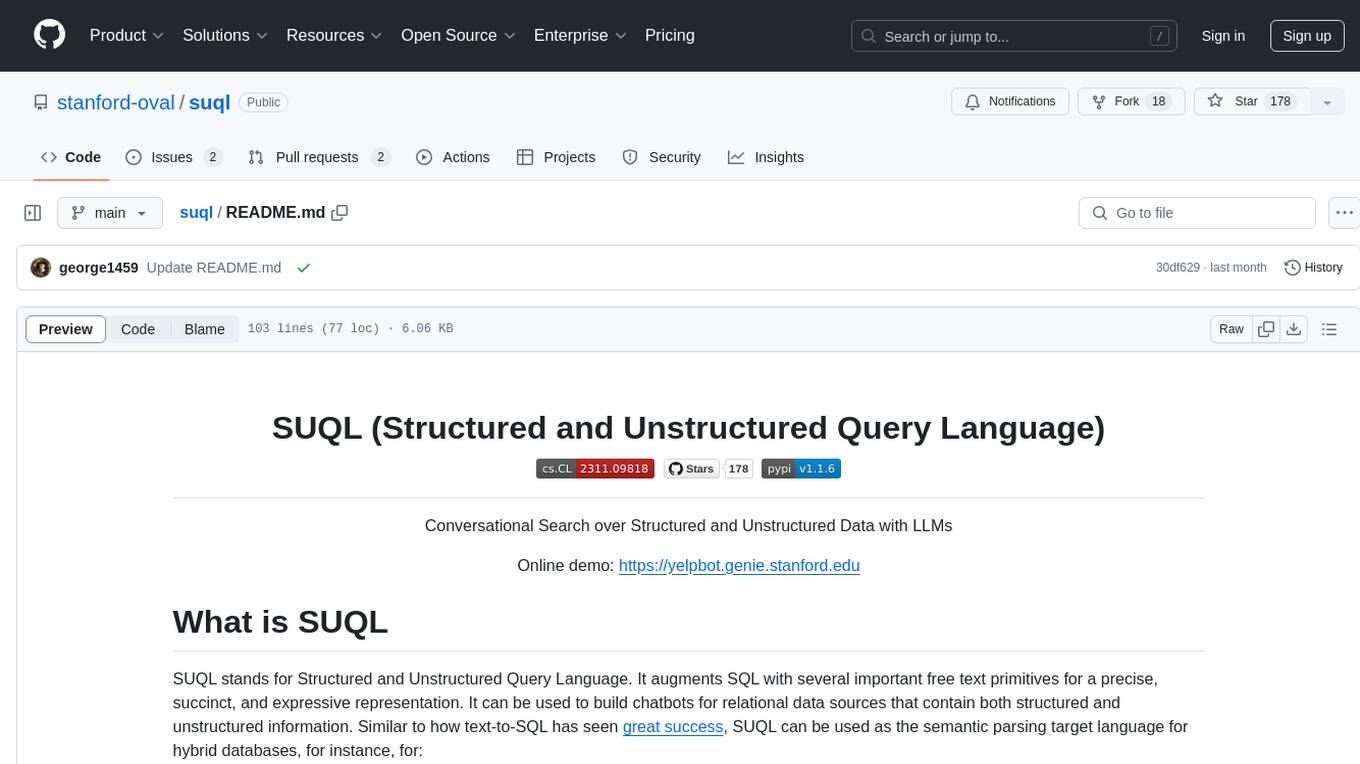
suql
SUQL (Structured and Unstructured Query Language) is a tool that augments SQL with free text primitives for building chatbots that can interact with relational data sources containing both structured and unstructured information. It seamlessly integrates retrieval models, large language models (LLMs), and traditional SQL to provide a clean interface for hybrid data access. SUQL supports optimizations to minimize expensive LLM calls, scalability to large databases with PostgreSQL, and general SQL operations like JOINs and GROUP BYs.
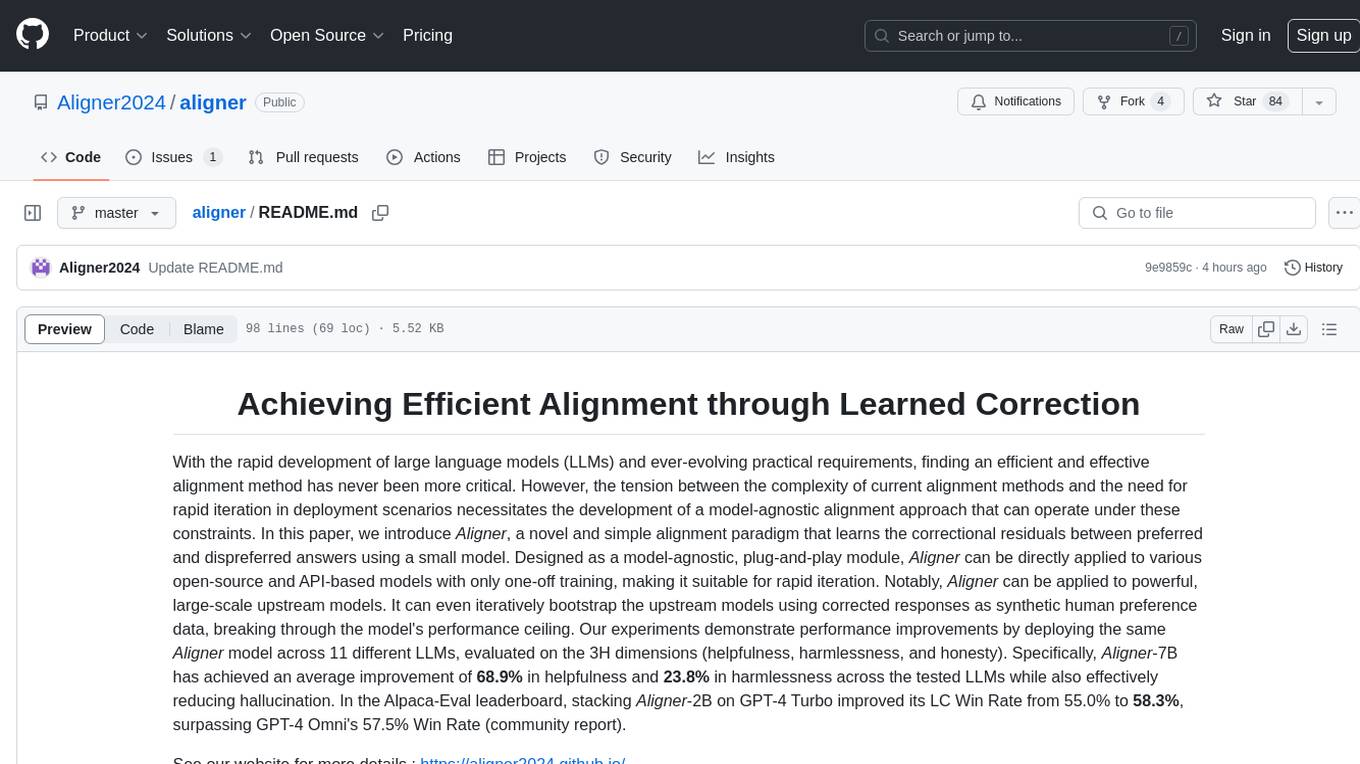
aligner
Aligner is a model-agnostic alignment tool that learns correctional residuals between preferred and dispreferred answers using a small model. It can be directly applied to various open-source and API-based models with only one-off training, suitable for rapid iteration and improving model performance. Aligner has shown significant improvements in helpfulness, harmlessness, and honesty dimensions across different large language models.
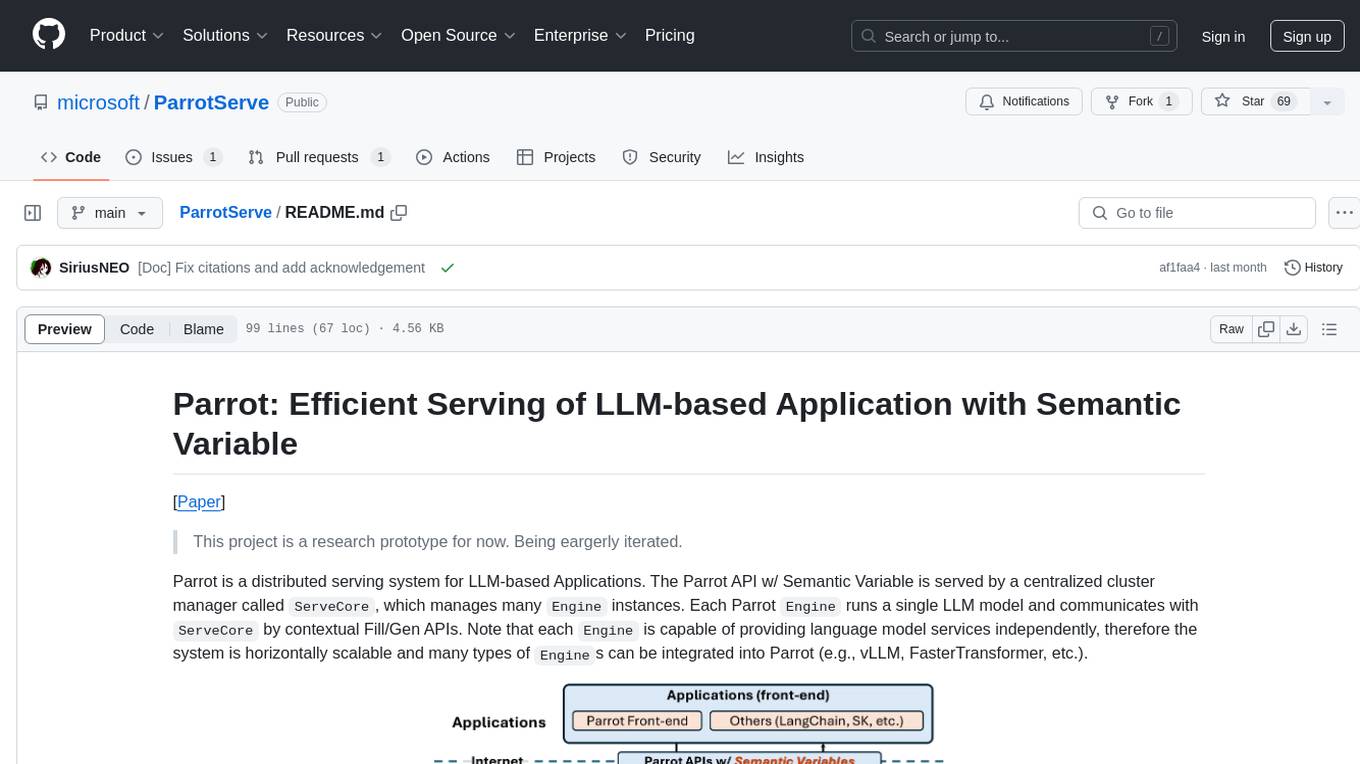
ParrotServe
Parrot is a distributed serving system for LLM-based Applications, designed to efficiently serve LLM-based applications by adding Semantic Variable in the OpenAI-style API. It allows for horizontal scalability with multiple Engine instances running LLM models communicating with ServeCore. The system enables AI agents to interact with LLMs via natural language prompts for collaborative tasks.
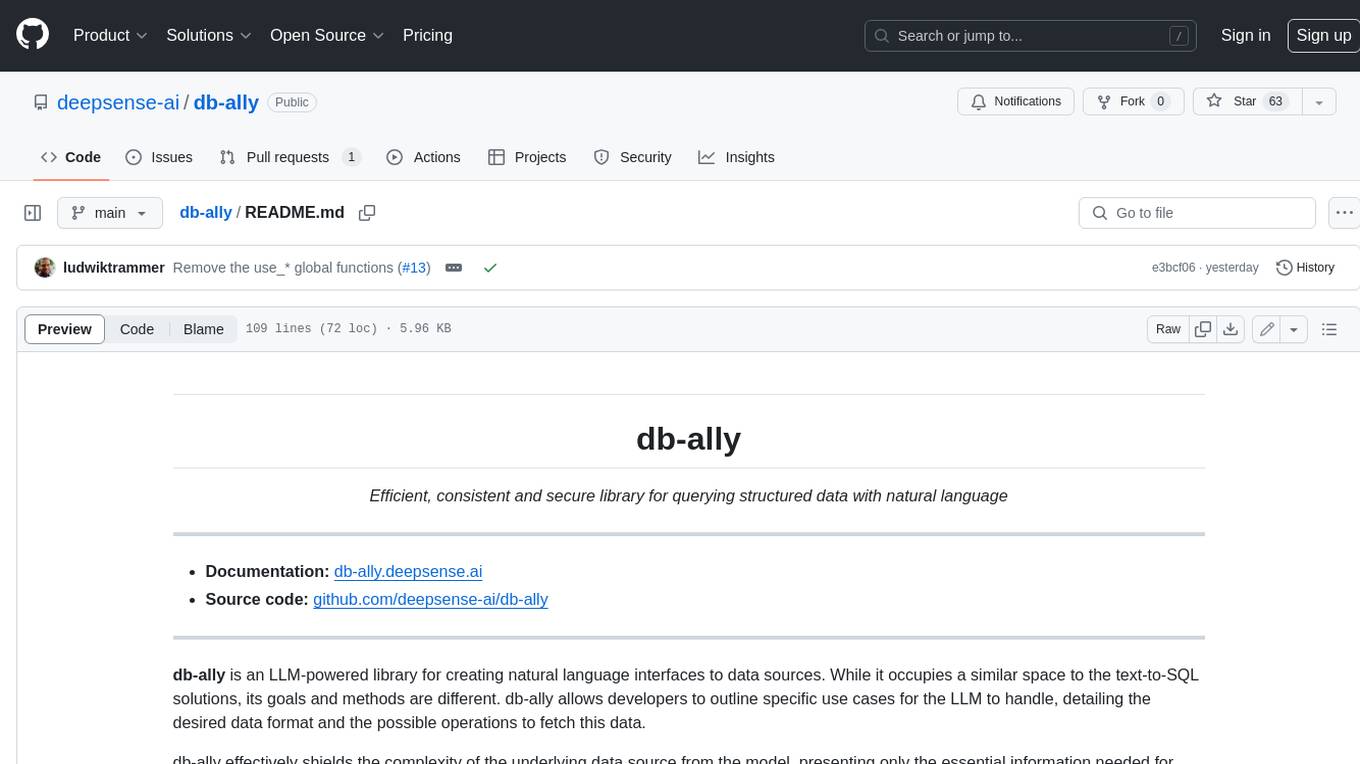
db-ally
db-ally is a library for creating natural language interfaces to data sources. It allows developers to outline specific use cases for a large language model (LLM) to handle, detailing the desired data format and the possible operations to fetch this data. db-ally effectively shields the complexity of the underlying data source from the model, presenting only the essential information needed for solving the specific use cases. Instead of generating arbitrary SQL, the model is asked to generate responses in a simplified query language.
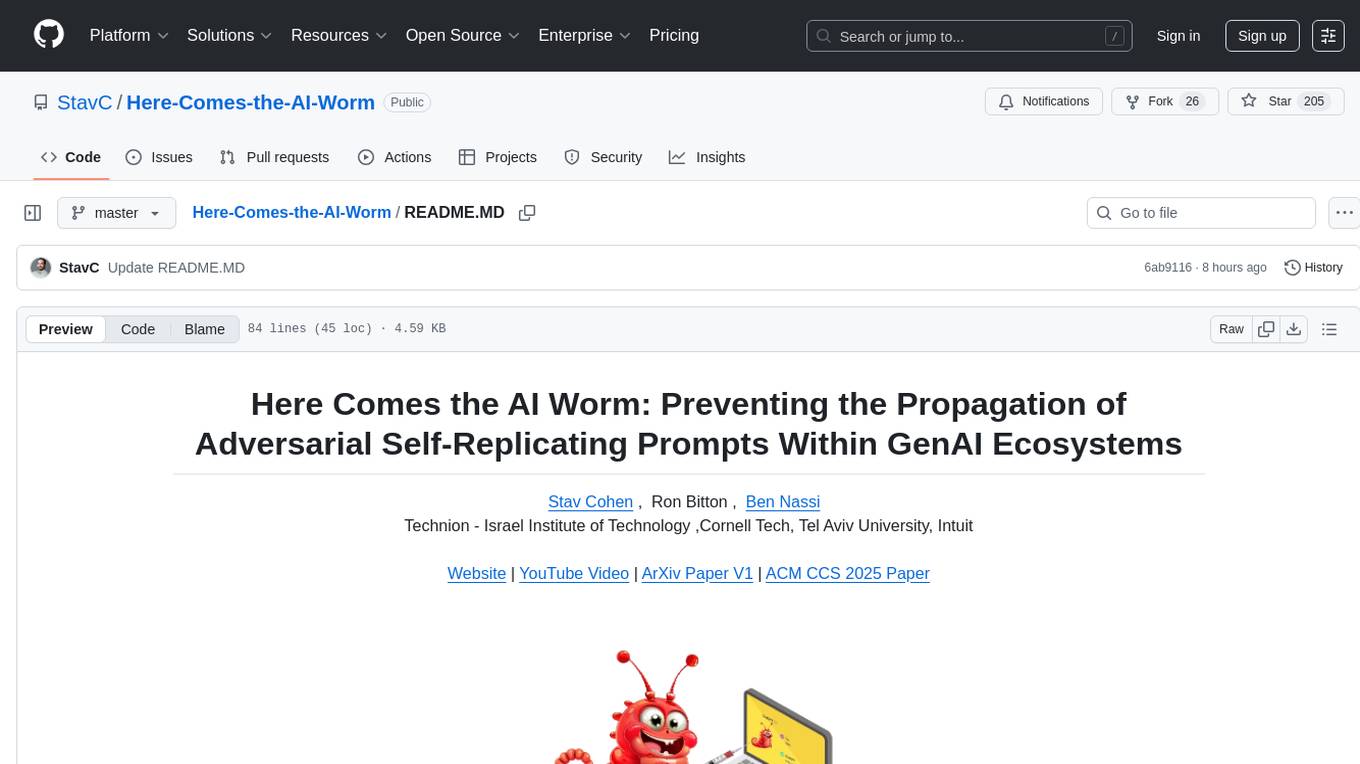
Here-Comes-the-AI-Worm
Large Language Models (LLMs) are now embedded in everyday tools like email assistants, chat apps, and productivity software. This project introduces DonkeyRail, a lightweight guardrail that detects and blocks malicious self-replicating prompts known as RAGworm within GenAI-powered applications. The guardrail is fast, accurate, and practical for real-world GenAI systems, preventing activities like spam, phishing campaigns, and data leaks.
For similar tasks

Me-LLaMA
Me LLaMA introduces a suite of open-source medical Large Language Models (LLMs), including Me LLaMA 13B/70B and their chat-enhanced versions. Developed through innovative continual pre-training and instruction tuning, these models leverage a vast medical corpus comprising PubMed papers, medical guidelines, and general domain data. Me LLaMA sets new benchmarks on medical reasoning tasks, making it a significant asset for medical NLP applications and research. The models are intended for computational linguistics and medical research, not for clinical decision-making without validation and regulatory approval.
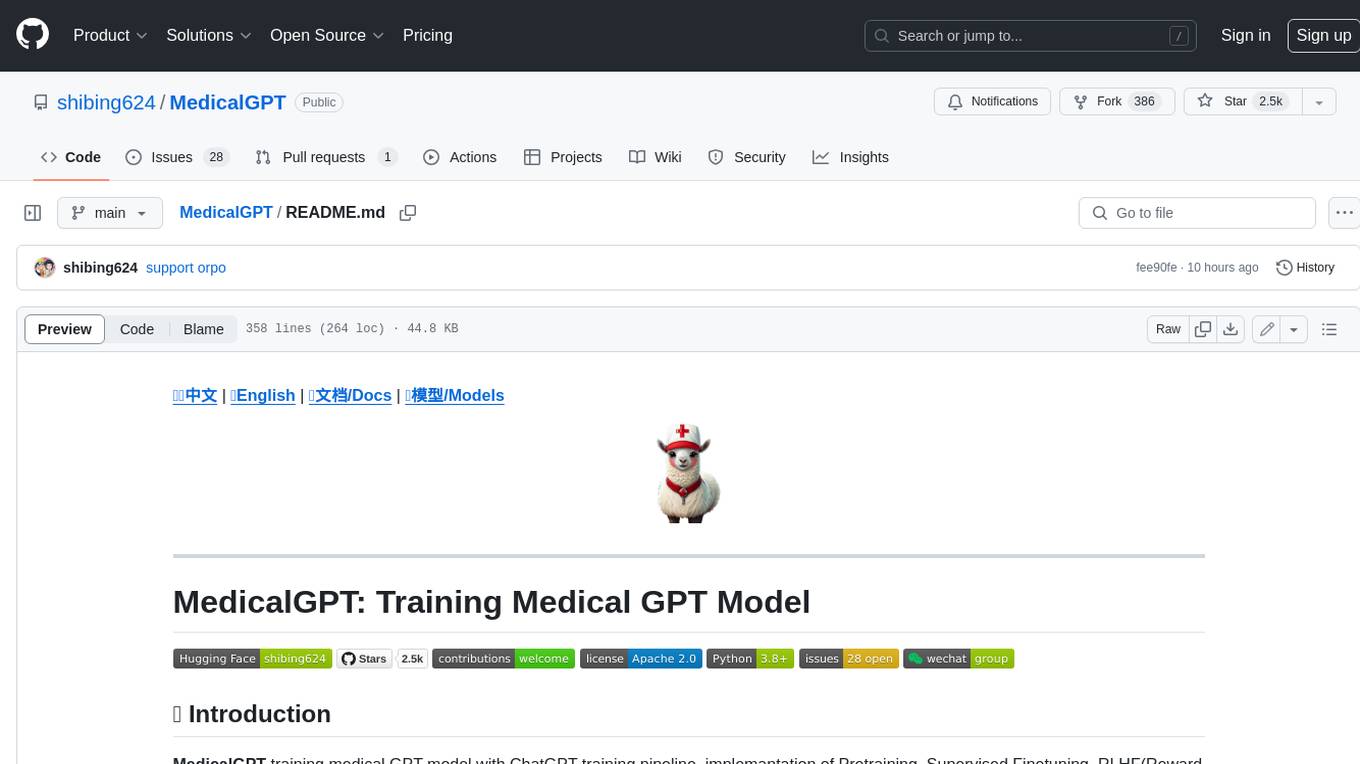
MedicalGPT
MedicalGPT is a training medical GPT model with ChatGPT training pipeline, implement of Pretraining, Supervised Finetuning, RLHF(Reward Modeling and Reinforcement Learning) and DPO(Direct Preference Optimization).
For similar jobs

Me-LLaMA
Me LLaMA introduces a suite of open-source medical Large Language Models (LLMs), including Me LLaMA 13B/70B and their chat-enhanced versions. Developed through innovative continual pre-training and instruction tuning, these models leverage a vast medical corpus comprising PubMed papers, medical guidelines, and general domain data. Me LLaMA sets new benchmarks on medical reasoning tasks, making it a significant asset for medical NLP applications and research. The models are intended for computational linguistics and medical research, not for clinical decision-making without validation and regulatory approval.
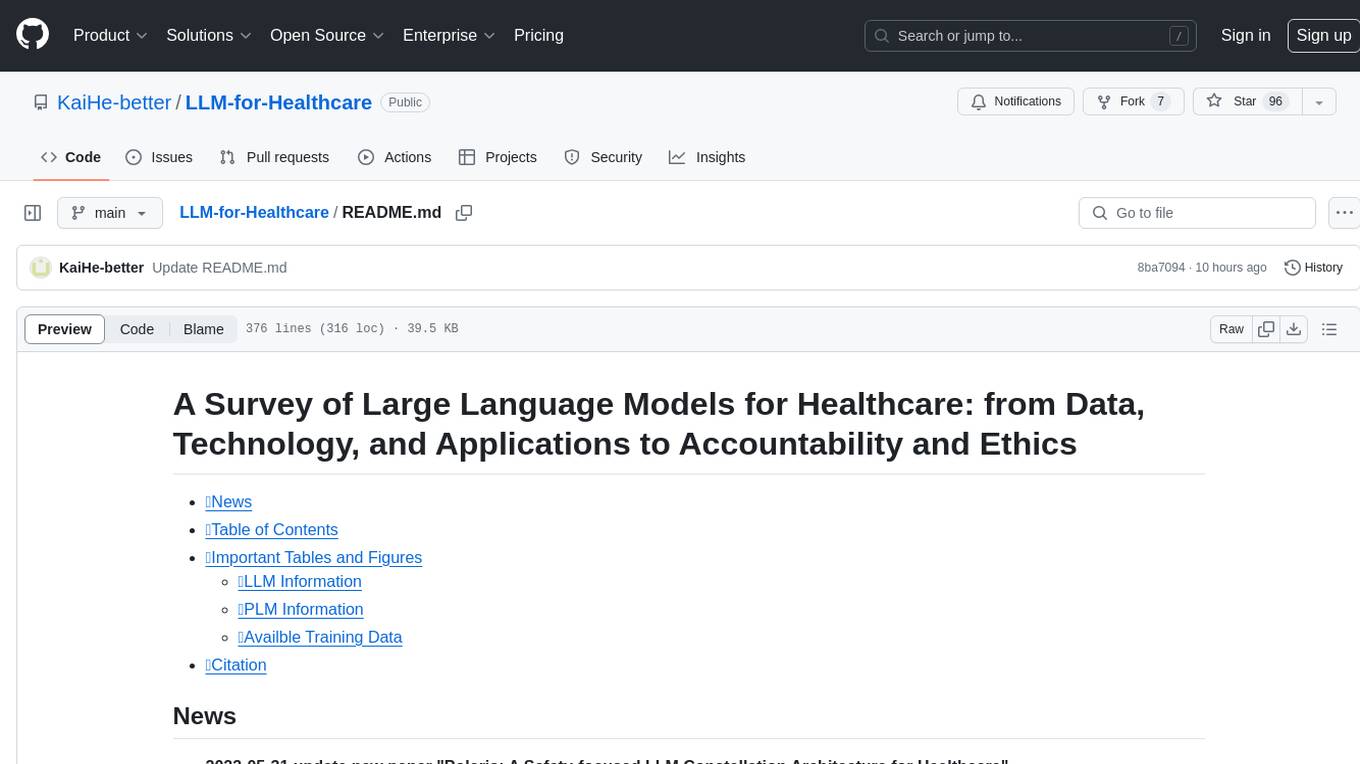
LLM-for-Healthcare
The repository 'LLM-for-Healthcare' provides a comprehensive survey of large language models (LLMs) for healthcare, covering data, technology, applications, and accountability and ethics. It includes information on various LLM models, training data, evaluation methods, and computation costs. The repository also discusses tasks such as NER, text classification, question answering, dialogue systems, and generation of medical reports from images in the healthcare domain.
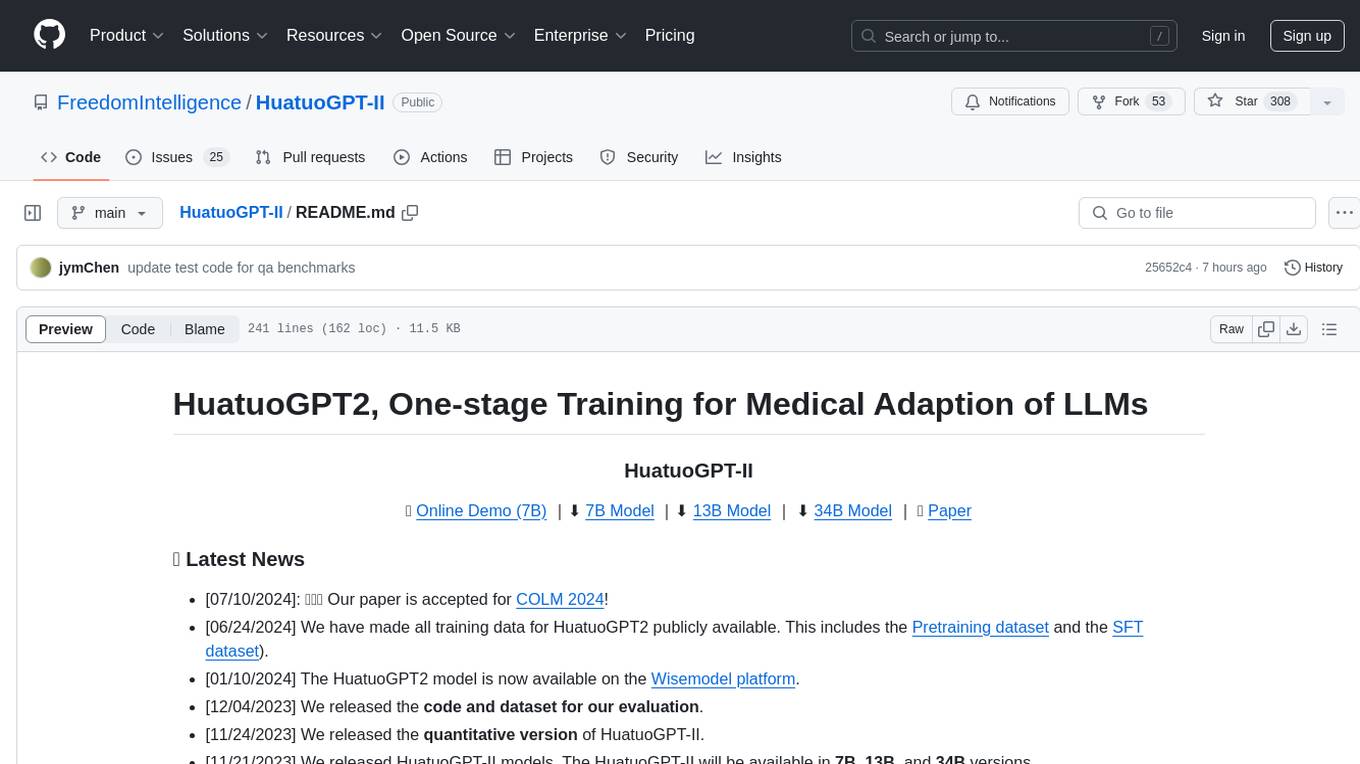
HuatuoGPT-II
HuatuoGPT2 is an innovative domain-adapted medical large language model that excels in medical knowledge and dialogue proficiency. It showcases state-of-the-art performance in various medical benchmarks, surpassing GPT-4 in expert evaluations and fresh medical licensing exams. The open-source release includes HuatuoGPT2 models in 7B, 13B, and 34B versions, training code for one-stage adaptation, partial pre-training and fine-tuning instructions, and evaluation methods for medical response capabilities and professional pharmacist exams. The tool aims to enhance LLM capabilities in the Chinese medical field through open-source principles.
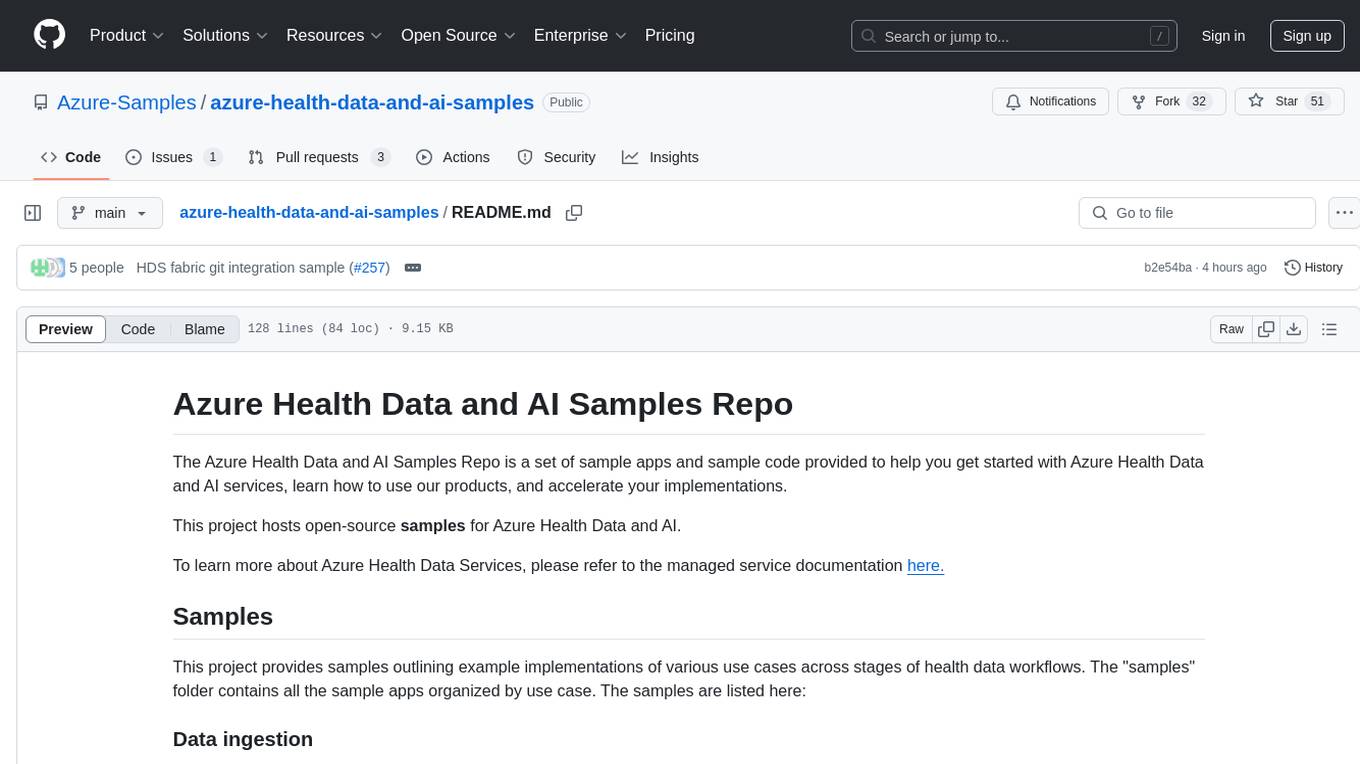
azure-health-data-and-ai-samples
The Azure Health Data and AI Samples Repo is a collection of sample apps and code to help users start with Azure Health Data and AI services, learn product usage, and speed up implementations. It includes samples for various health data workflows, such as data ingestion, analytics, machine learning, SMART on FHIR, patient services, FHIR service integration, Azure AD B2C access, DICOM service, MedTech service, and healthcare data solutions in Microsoft Fabric. These samples are simplified scenarios for testing purposes only.
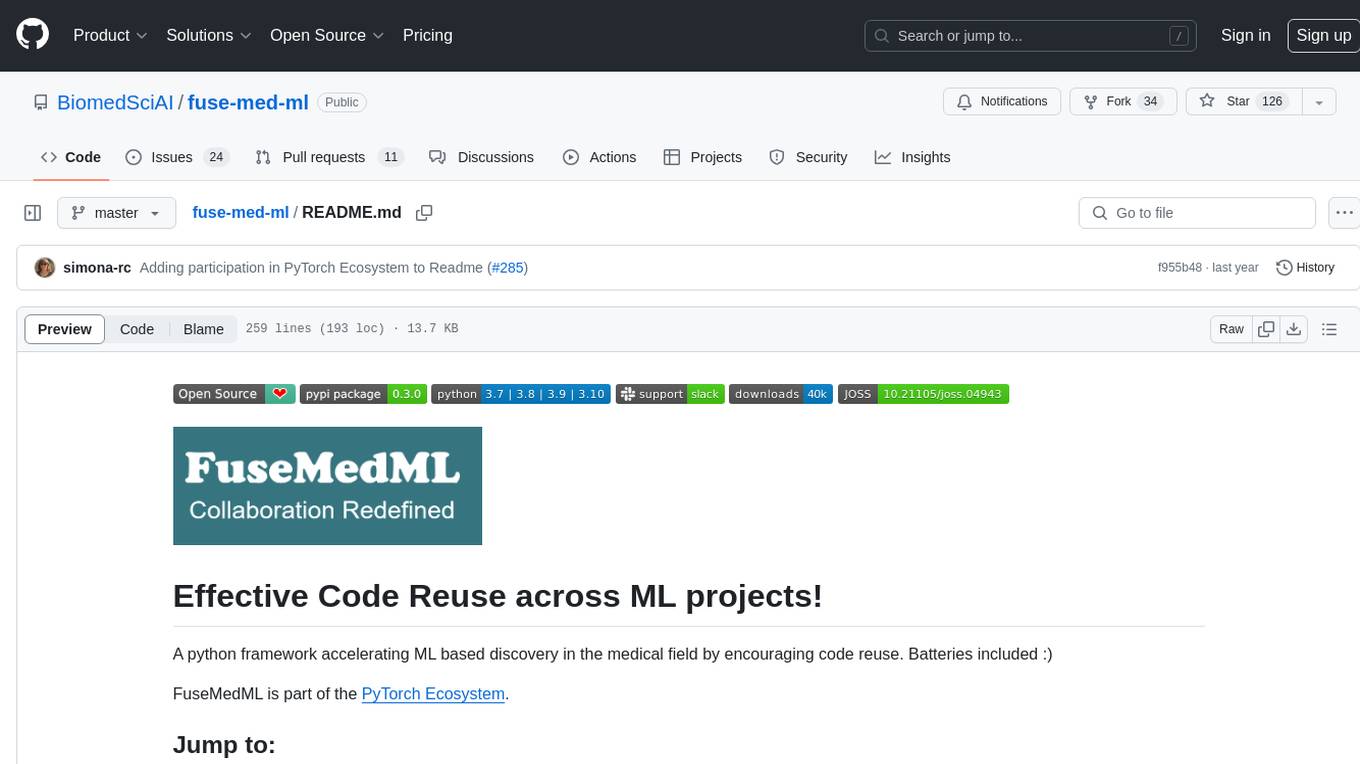
fuse-med-ml
FuseMedML is a Python framework designed to accelerate machine learning-based discovery in the medical field by promoting code reuse. It provides a flexible design concept where data is stored in a nested dictionary, allowing easy handling of multi-modality information. The framework includes components for creating custom models, loss functions, metrics, and data processing operators. Additionally, FuseMedML offers 'batteries included' key components such as fuse.data for data processing, fuse.eval for model evaluation, and fuse.dl for reusable deep learning components. It supports PyTorch and PyTorch Lightning libraries and encourages the creation of domain extensions for specific medical domains.
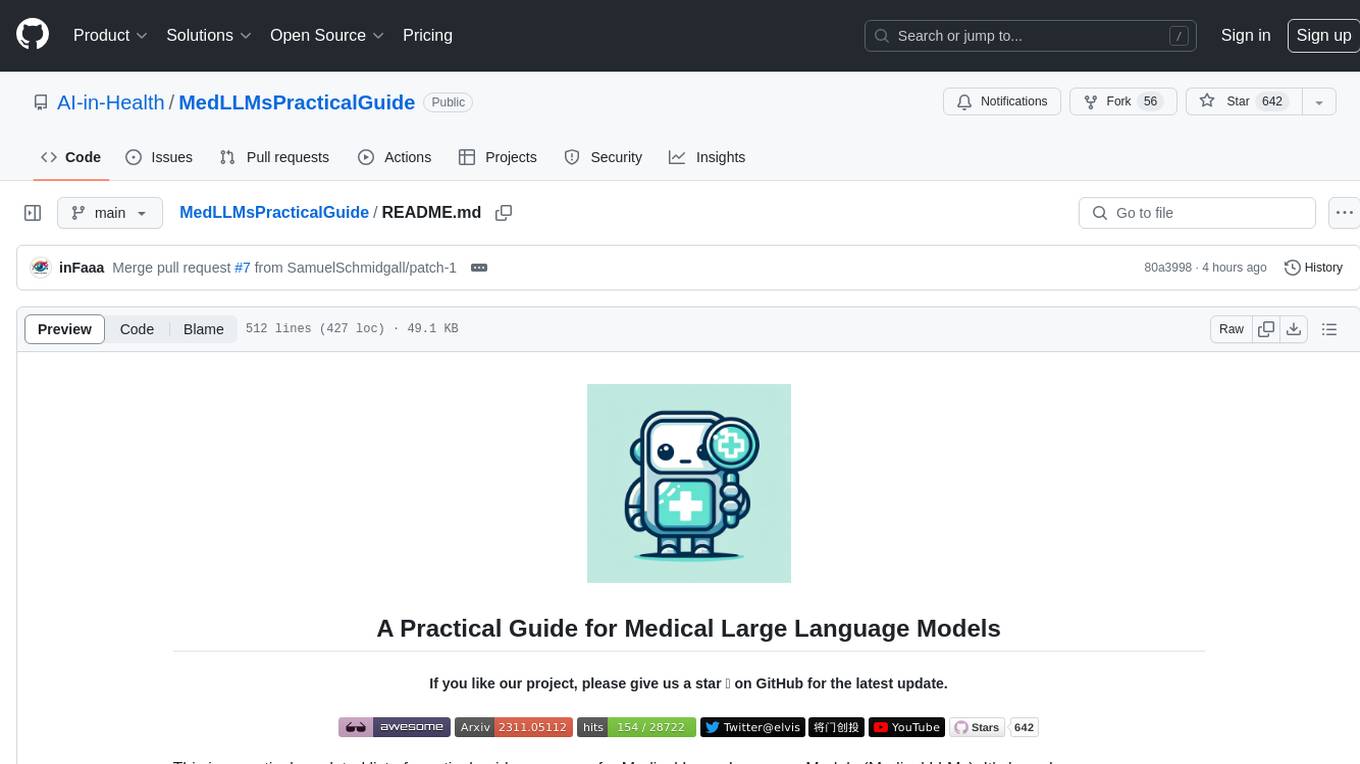
MedLLMsPracticalGuide
This repository serves as a practical guide for Medical Large Language Models (Medical LLMs) and provides resources, surveys, and tools for building, fine-tuning, and utilizing LLMs in the medical domain. It covers a wide range of topics including pre-training, fine-tuning, downstream biomedical tasks, clinical applications, challenges, future directions, and more. The repository aims to provide insights into the opportunities and challenges of LLMs in medicine and serve as a practical resource for constructing effective medical LLMs.
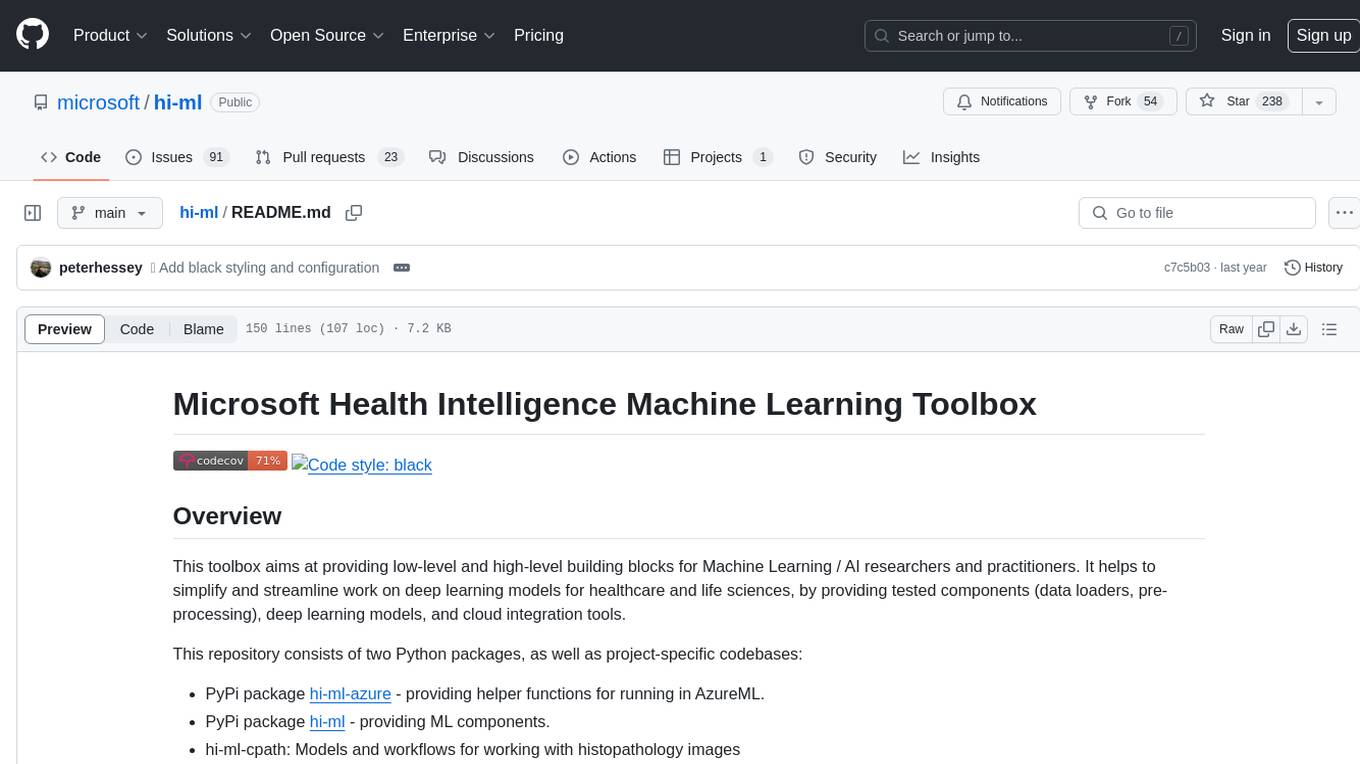
hi-ml
The Microsoft Health Intelligence Machine Learning Toolbox is a repository that provides low-level and high-level building blocks for Machine Learning / AI researchers and practitioners. It simplifies and streamlines work on deep learning models for healthcare and life sciences by offering tested components such as data loaders, pre-processing tools, deep learning models, and cloud integration utilities. The repository includes two Python packages, 'hi-ml-azure' for helper functions in AzureML, 'hi-ml' for ML components, and 'hi-ml-cpath' for models and workflows related to histopathology images.
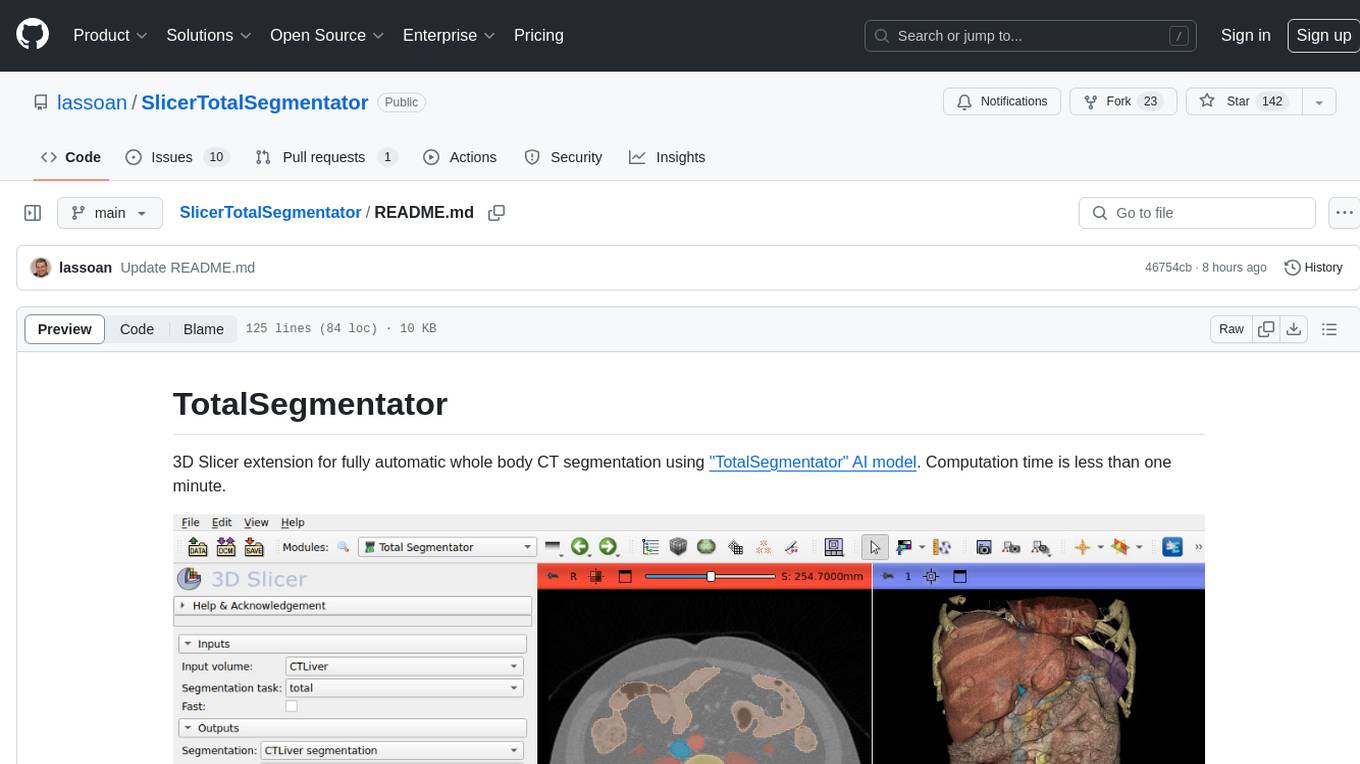
SlicerTotalSegmentator
TotalSegmentator is a 3D Slicer extension designed for fully automatic whole body CT segmentation using the 'TotalSegmentator' AI model. The computation time is less than one minute, making it efficient for research purposes. Users can set up GPU acceleration for faster segmentation. The tool provides a user-friendly interface for loading CT images, creating segmentations, and displaying results in 3D. Troubleshooting steps are available for common issues such as failed computation, GPU errors, and inaccurate segmentations. Contributions to the extension are welcome, following 3D Slicer contribution guidelines.